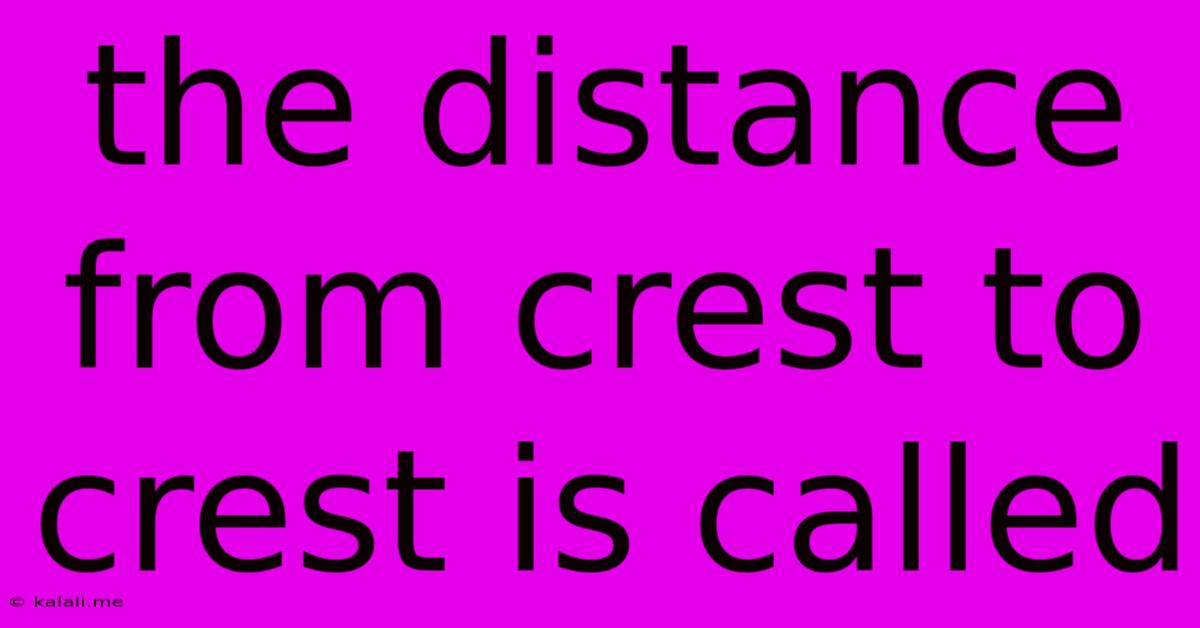The Distance From Crest To Crest Is Called
Kalali
Jun 14, 2025 · 3 min read

Table of Contents
The Distance From Crest to Crest Is Called: Wavelength Explained
The distance from one crest to the next crest of a wave is called the wavelength. Understanding wavelength is crucial in various fields, from physics and engineering to music and oceanography. This article will delve into the definition of wavelength, its importance, and how it's measured and applied in different contexts.
What is a Wavelength?
A wave, whether it's a sound wave, a light wave, or a wave in the ocean, is characterized by its repetitive pattern. The wavelength is the spatial period of a periodic wave—the distance over which the wave's shape repeats. In simpler terms, it's the distance between two consecutive identical points on a wave. These identical points could be two crests (the highest points), two troughs (the lowest points), or any other corresponding points on the wave's waveform.
Measuring wavelength involves identifying a specific point on the wave and then measuring the distance to the next identical point along the direction of the wave's propagation. This distance is the wavelength.
How is Wavelength Measured?
Wavelength is typically represented by the Greek letter lambda (λ). Its measurement depends on the type of wave and the tools available. For visible light, specialized instruments like spectrometers are used to measure wavelength precisely. For sound waves, the wavelength can be calculated using the wave's frequency and speed. For water waves, direct measurement using rulers or other measuring devices may be feasible. The units for wavelength are usually meters (m), but other units like nanometers (nm) for light waves or centimeters (cm) for water waves may also be used.
Wavelength's Importance Across Different Fields
Wavelength plays a significant role in various scientific and technological applications. Here are some examples:
-
Electromagnetic Spectrum: Different wavelengths of electromagnetic radiation correspond to different types of radiation, such as radio waves, microwaves, infrared radiation, visible light, ultraviolet radiation, X-rays, and gamma rays. The wavelength determines the energy and properties of the radiation. For instance, shorter wavelengths like those of X-rays have higher energy than longer wavelengths like those of radio waves.
-
Optics and Spectroscopy: In optics, the wavelength of light influences its color and how it interacts with materials. Spectroscopy uses the wavelengths of light absorbed or emitted by a substance to identify its composition.
-
Acoustics: In acoustics, the wavelength of sound waves influences the pitch and timbre of sounds. Longer wavelengths correspond to lower pitches, and shorter wavelengths correspond to higher pitches. The wavelength also affects sound propagation and diffraction.
-
Oceanography: The wavelength of ocean waves is crucial for understanding their behavior and predicting their impact on coastal areas. Large wavelength waves typically have more destructive power than shorter wavelength waves.
Frequency and Wavelength Relationship
Wavelength is inversely proportional to frequency (f). Frequency measures how many wave cycles pass a point in one second. The relationship is described by the equation: λ = v/f, where 'v' is the wave's velocity (speed of propagation). This means that waves with high frequency have short wavelengths, and waves with low frequency have long wavelengths.
Conclusion
The distance from crest to crest, or any two corresponding points on a wave, is known as the wavelength. It's a fundamental concept in understanding wave behavior across a vast range of scientific disciplines and has critical applications in numerous technologies. Understanding wavelength is essential for comprehending the properties and interactions of waves in various contexts.
Latest Posts
Latest Posts
-
The End Product Of Protein Digestion Is
Jun 15, 2025
-
The Speed Of A Printer Is Measured In
Jun 15, 2025
-
Whats The Prime Factorization Of 63
Jun 15, 2025
-
Which Statement About Green Plants Is True
Jun 15, 2025
-
What Is The Least Common Multiple Of 10 And 14
Jun 15, 2025
Related Post
Thank you for visiting our website which covers about The Distance From Crest To Crest Is Called . We hope the information provided has been useful to you. Feel free to contact us if you have any questions or need further assistance. See you next time and don't miss to bookmark.